继电保护代码
- 格式:doc
- 大小:125.50 KB
- 文档页数:6
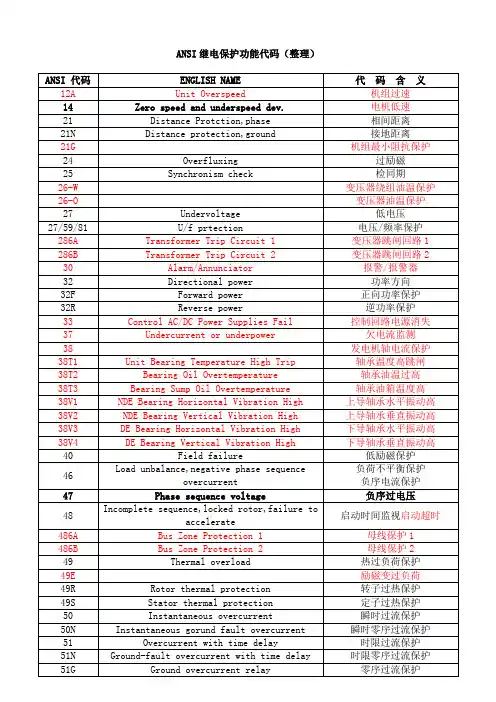
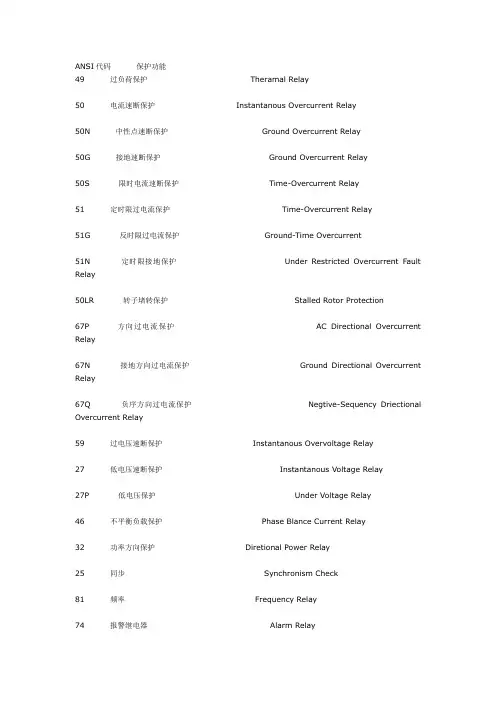
ANSI代码保护功能49 过负荷保护Theramal Relay50 电流速断保护 Instantanous Overcurrent Relay50N 中性点速断保护Ground Overcurrent Relay50G 接地速断保护 Ground Overcurrent Relay50S 限时电流速断保护 Time-Overcurrent Relay51 定时限过电流保护Time-Overcurrent Relay51G 反时限过电流保护Ground-Time Overcurrent51N 定时限接地保护Under Restricted Overcurrent Fault Relay50LR 转子堵转保护 Stalled Rotor Protection67P 方向过电流保护AC Directional Overcurrent Relay67N 接地方向过电流保护 Ground Directional Overcurrent Relay67Q 负序方向过电流保护Negtive-Sequency Driectional Overcurrent Relay59 过电压速断保护 Instantanous Overvoltage Relay27 低电压速断保护 Instantanous Voltage Relay27P 低电压保护Under Voltage Relay46 不平衡负载保护 Phase Blance Current Relay32 功率方向保护 Diretional Power Relay25 同步Synchronism Check81 频率Frequency Relay74 报警继电器 Alarm Relay68 联锁 Locking Relay78 失步Out-Of-Step Pretective Relay AST 备自投 Standby Power Auto SwitchT 温度保护 Temperature Protection21 距离保护Distance Relay87 差动保护Differential Protective Relay。
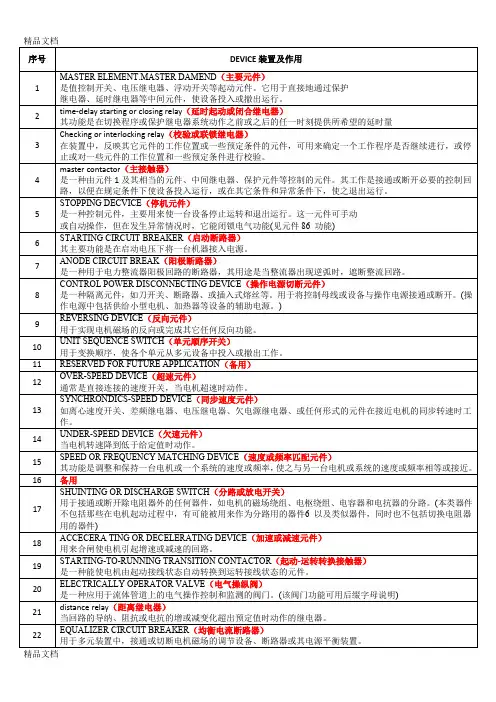
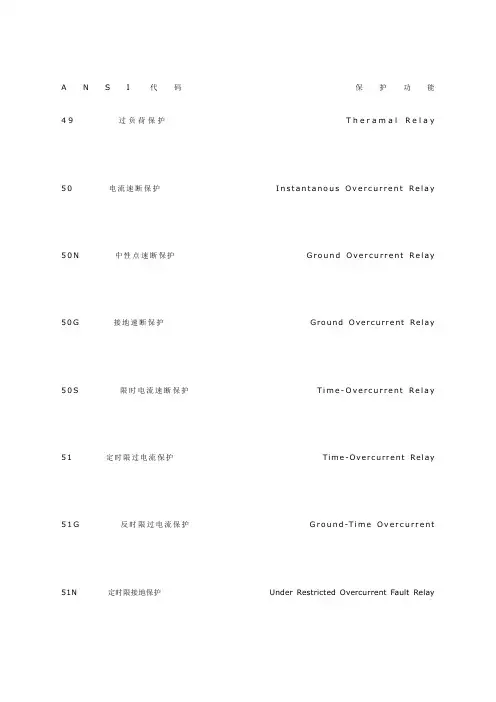
A N S I代码保护功能49过负荷保护T h e r a m a l R e l a y50电流速断保护I n s t a n t a n o u s O v e r c u r r e n t R e l a y50N中性点速断保护G r o u n d O v e r c u r r e n t R e l a y50G接地速断保护G r o u n d O v e r c u r r e n t Re l a y50S限时电流速断保护T i m e-O v e r c u r r e n t R e l a y51定时限过电流保护T i m e-Ove r c u r r e n t Re l ay51G反时限过电流保护G r o u n d-T i m e O v e r c u r r e n t51N 定时限接地保护Under Restricted Overcurrent Fault Relay50LR 转子堵转保护 Stalled Rotor Protection67P 方向过电流保护AC Directional Overcurrent Relay 67N 接地方向过电流保护 Ground Directional Overcurrent Relay67Q 负序方向过电流保护Negtive-Sequency Driectional O v e r c u r r e n t R e l a y59过电压速断保护I n s t a nt a no u s Ove r vo l t ag e Re l ay 27 低电压速断保护 Instantanous Voltage Relay 27P 低电压保护U nd e r Vo l t ag e Re l ay 46不平衡负载保护P h a s e B l a n c e C u r r e n t Re l ay32功率方向保护D i r e t i o n a l P o w e r R e l a y 25同步S y n c h r o n i s m C h e c k 81频率F r e q u e n c y R e l a y 74报警继电器A l a r m R e l a y 68联锁L o c k i n g R e l a y78 失步Out-Of-Step Pretective RelayA S T备自投S t a n d b y P o w e r A u t o S w i t c h T温度保护Te m p e r a t u r e P r o t e c t i o n 21距离保护D i s t a n c e R e l a y87差动保护D i f f e r e n t i a l P r o t e c t i v e R e l a y。

The ANSI Standard Device Numbers[1] [2] [3] denote what features a protective device supports (such as a relay or circuit breaker). These types of devices protect electrical systems and components from damage when an unwanted event occurs, such as an electrical fault.[edit] List of Device Numbers1 - Master Element2 - Time Delay Starting or Closing Relay3 - Checking or Interlocking Relay4 - Master Contactor5 - Stopping Device6 - Starting Circuit Breaker7 - Anode Circuit Breaker8 - Control Power Disconnecting Device9 - Reversing Device10 - Unit Sequence Switch11 - Reserved for future application12 - Overspeed Device13 - Synchronous-speed Device14 - Underspeed Device15 - Speed - or Frequency, Matching Device16 - Reserved for future application17 - Shunting or Discharge Switch18 - Accelerating or Decelerating Device19 - Starting to Running Transition Contactor20 - Electrically Operated Valve21 - Distance Relay22 - Equalizer Circuit Breaker23 - Temperature Control Device24 - Over-Excitation Relay25 - Synchronizing or Synchronism-Check Device26 - Apparatus Thermal Device27 - Undervoltage Relay28 - Flame Detector29 - Isolating Contactor30 - Annunciator Relay31 - Separate Excitation Device32 - Directional Power Relay33 - Position Switch34 - Master Sequence Device35 - Brush-Operating or Slip-Ring Short-Circuiting, Device36 - Polarity or Polarizing Voltage Devices37 - Undercurrent or Underpower Relay38 - Bearing Protective Device39 - Mechanical Conduction Monitor40 - Field Relay41 - Field Circuit Breaker42 - Running Circuit Breaker43 - Manual Transfer or Selector Device44 - Unit Sequence Starting Relay45 - Atmospheric Condition Monitor46 - Reverse-phase or Phase-Balance Current Relay47 - Phase-Sequence Voltage Relay48 - Incomplete Sequence Relay49 - Machine or Transformer, Thermal Relay50 - Instantaneous Overcurrent or Rate of Rise, Relay51 - AC Time Overcurrent Relay52 - AC Circuit Breaker53 - Exciter or DC Generator Relay54 - High-Speed DC Circuit Breaker55 - Power Factor Relay56 - Field Application Relay57 - Short-Circuiting or Grounding (Earthing) Device58 - Rectification Failure Relay59 - Overvoltage Relay60 - Voltage or Current Balance Relay61 - Machine Split Phase Current Balance62 - Time-Delay Stopping or Opening Relay63 - Pressure Switch64 - Ground (Earth) Detector Relay65 - Governor66 - Notching or Jogging Device67 - AC Directional Overcurrent Relay68 - Blocking Relay69 - Permissive Control Device70 - Rheostat71 - Level Switch72 - DC Circuit Breaker73 - Load-Resistor Contactor74 - Alarm Relay75 - Position Changing Mechanism76 - DC Overcurrent Relay77 - Pulse Transmitter78 - Phase-Angle Measuring or Out-of-Step Protective Relay79 - AC Reclosing Relay80 - Flow Switch81 - Frequency Relay82 - DC Reclosing Relay83 - Automatic Selective Control or Transfer Relay84 - Operating Mechanism85 - Carrier or Pilot-Wire Receiver Relay86 - Lockout Relay87 - Differential Protective Relay88 - Auxiliary Motor or Motor Generator89 - Line Switch90 - Regulating Device91 - Voltage Directional Relay92 - Voltage and Power Directional Relay93 - Field Changing Contactor94 - Tripping or Trip-Free Relay95 - Reluctance Torque Synchrocheck96 - Autoloading Relay97 - For specific applications where other numbers are not suitable98 - For specific applications where other numbers are not suitable99 - For specific applications where other numbers are not suitableNote 1: A suffix letter may be used with the device number; for example, suffix N is used if the device is connected to a Neutral wire (example: 59N in Siemens Relay is used for protection against Neutral Displacement); and suffixes X,Y,Z are used for auxiliary devices. Similarly, the "G" suffix denotes a "ground", hence a "51G" being a time overcurrent ground relay[4].Note 2: A suffix number may also be used with a device number: numbers are used to distinguish multiple "same" devices in the same equipment such as 51-1, 51-2.Note 3: Device numbers may be combined if the device provides multiple functions, such as the instantaneous/time-delay AC over current relay denoted as 50/51Note 4: For function descriptions, refer to IEEE standards reference library or American Standards C37. For understanding and learning application of these devices, many technical reference books have been published and are are available. These device numbers and their application are typically in the domain of electrical engineers, specifically power generation, transmission or distribution system engineers in regards to safely controlling and protecting users and equipment2 Time-Delay Starting Or Closing Relay8 Control Power Disconnecting Device12 Over-Speed Protection21 Distance Relay24 Over-Excitation (V/Hz)25 Synchronizing Or Synchronism Check Device26 Machine Field Overtemperature27 Undervoltage Device27 Machine Field Undervoltage Device27TN Third Harmonic Neutral Undervoltage30 Annunciator Relay, Multifunction Relays32 Directional Power Device37 Undercurrent Device,37 Machine Field Undercurrent Device38 Bearing Overtemperature40 Loss Of Field Or Excitation Device (Impedance)40Q Loss Of Field Or Excitation Device (Reactive Power)46 Reverse-Phase Or Phase-Balance Current Relay47 Phase-Sequence Voltage Relay48 Incomplete Sequence49 Stator Overtemperature49 Thermal Image Relay50/27 Inadvertent Generator Energization50 Instantaneous Overcurrent Or Rate-Of-Rise Relay51 AC Time Overcurrent Relay50/51 Instantaneous And Time Overcurrent Relay50/51(+) Overcurrent Relay51V Voltage Restraint Overcurrent Device50BF Breaker Failure Relay55 Power Factor Relay56 Field Application Device59 Overvoltage Relay59N Neutral Overvoltage Device60 Voltage Or Current Balance Relay61 Machine Split Phase Current Balance64 Ground Detector Relay64TN 100% Stator Ground Device66 Starts Per Hours67 AC Directional Overcurrent Relay67_2 Negative Sequence Directional Overcurrent68 Blocking Relay69 Circuit Breaker Supervision And Control Device74 Alarm Relay Multifunction Relays76 DC Overcurrent Relay78 Phase Angle MeasuringOr Out-Of-Step Protective Relay79 AC Reclosing Relay81 Frequency Relay81R Rate of Change of Frequency84 Transformer Tap Changer Control Device85 Carrier Or Pilot-Wire Receiver Relay86 Lockout Relay87 Differential Protective Relay87L Line Current Differential Relay L9087T Transformer Differential System87S Machine Stator Differential Protection System 87G Ground Differential or Restricted Ground Fault 87(+) Differential Relay94 Tripping Or Trip-Free Relay Multifunction Relays95 Reluctance Torque Synchrocheck SPM96 Autoloading Relay。
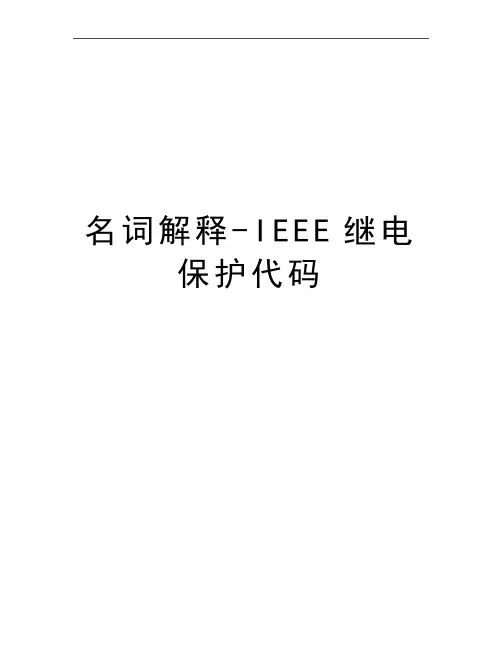
名词解释-I E E E继电保护代码名词解释-IEEE继电保护代码国外工程及电气设备厂商的保护配置图,特别是采用北美标准的,保护功能和元件通常采用数字代号表示,国内工程师搞得不知所云,为了使电力专业的工程设计人员逐步掌握国际工程语言,现收集相关资料,供大家参考。
保护数值代号其实遵循美国电机工程师协会标准(IEEE Std C37.2-1996),这种数字代码系统用于各种接线图、保护配置图、手册和说明书中。
无论是ABB、还是GE 设计的图纸,同样的一个元器件,其编号是不变的,如87就是代表差动继电器,51就是代表过流继电器。
下面介绍每个编号所代表的元件和功能。
1--master element主要元件,是指控制开关等元件。
它直接地或间接地通过保护继电器、延时继电器等中间元件,使设备投入或撤出运行。
注:本编号通常用于手动操作的元件,若某一电气或机务元件无其它功能编号可表示则也可使用本编号。
2--time-delay starting or closing relay延时起动或闭合继电器,其功能是在切换程序或保护继电器系统动作之前或之后的任一时刻提供所希望的延时量。
功能号48,6279 及82 定义的除外。
3--checking or interlocking relay校验或联锁继电器,在装置中,反映其它元件的工作位置或一些预定条件的元件,可用来确定一个工作程序是否继续进行,或停止或对一些元件的工作位置和一些预定条件进行校验。
4--master contactor主接触器是一种由元件1及其相当的元件、中间继电器、保护元件等控制的元件。
其工作是接通或断开必要的控制回路,以便在规定条件下使设备投入运行,或在其它条件和异常条件下,使之退出运行。
5--stopping device停机元件是一种控制元件,主要用来使一台设备停止运转和退出运行。
这一元件可手动或自动操作,但在发生异常情况时,它能闭锁电气功能(见元件86功能)6--starting circuit breaker启动断路器,其主要功能是在启动电压下将一台机器接入电源。
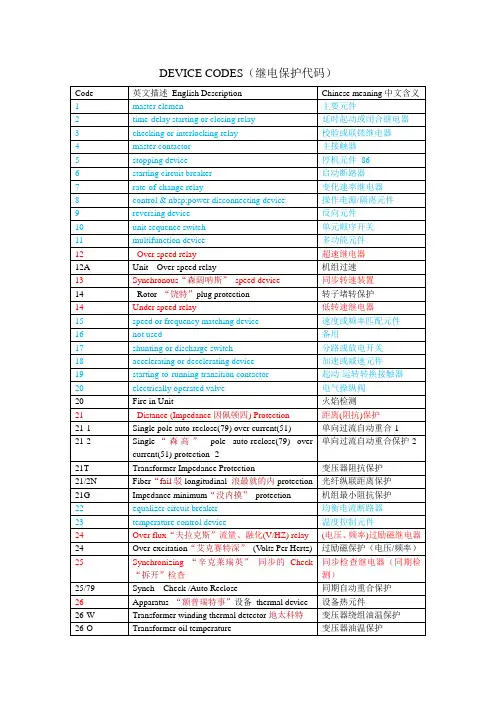
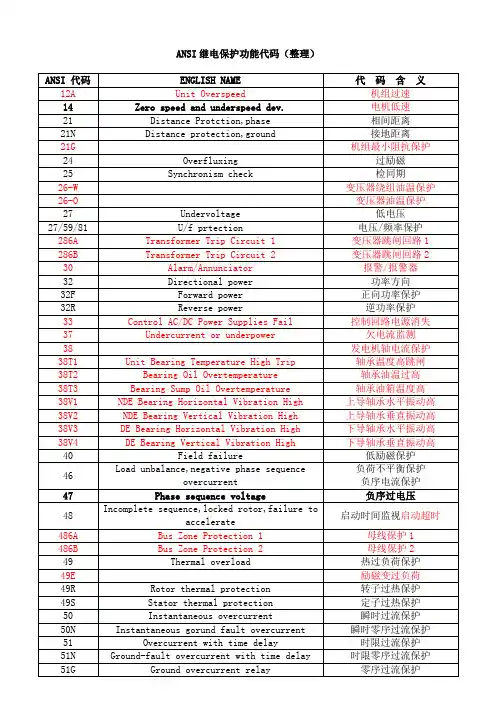

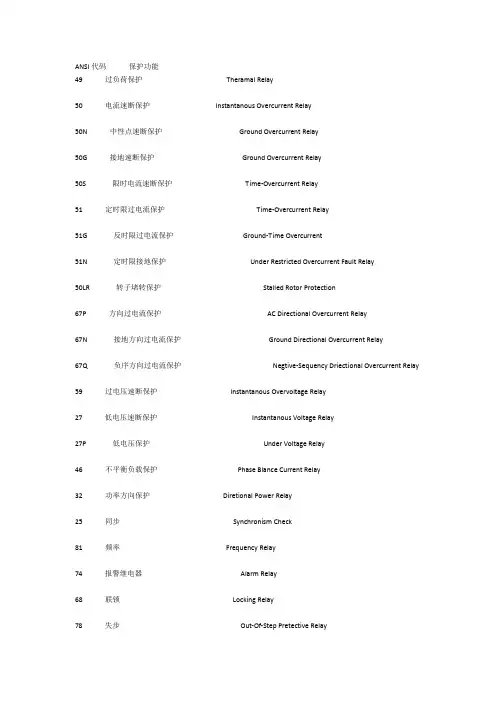
ANSI代码保护功能49 过负荷保护Theramal Relay50 电流速断保护 Instantanous Overcurrent Relay50N 中性点速断保护Ground Overcurrent Relay50G 接地速断保护 Ground Overcurrent Relay50S 限时电流速断保护 Time-Overcurrent Relay51 定时限过电流保护Time-Overcurrent Relay51G 反时限过电流保护Ground-Time Overcurrent51N 定时限接地保护Under Restricted Overcurrent Fault Relay50LR 转子堵转保护 Stalled Rotor Protection67P 方向过电流保护AC Directional Overcurrent Relay67N 接地方向过电流保护 Ground Directional Overcurrent Relay67Q 负序方向过电流保护Negtive-Sequency Driectional Overcurrent Relay 59 过电压速断保护 Instantanous Overvoltage Relay27 低电压速断保护 Instantanous Voltage Relay27P 低电压保护Under Voltage Relay46 不平衡负载保护 Phase Blance Current Relay32 功率方向保护 Diretional Power Relay25 同步Synchronism Check81 频率Frequency Relay74 报警继电器 Alarm Relay68 联锁 Locking Relay78 失步Out-Of-Step Pretective RelayAST 备自投 Standby Power Auto Switch T 温度保护 Temperature Protection 21 距离保护Distance Relay87 差动保护Differential Protective Relay。
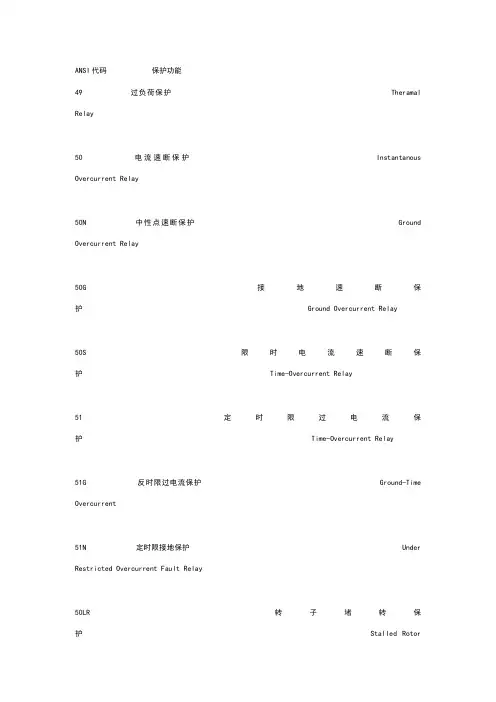
ANSI代码保护功能49 过负荷保护 Theramal Relay50 电流速断保护Instantanous Overcurrent Relay50N 中性点速断保护Ground Overcurrent Relay50G 接地速断保护Ground Overcurrent Relay50S 限时电流速断保护Time-Overcurrent Relay51 定时限过电流保护 Time-Overcurrent Relay51G 反时限过电流保护 Ground-Time Overcurrent51N 定时限接地保护 Under Restricted Overcurrent Fault Relay50LR 转子堵转保护Stalled RotorProtection67P 方向过电流保护AC Directional Overcurrent Relay67N 接地方向过电流保护Ground Directional Overcurrent Relay67Q 负序方向过电流保护 Negtive-Sequency Driectional Overcurrent Relay59 过电压速断保护Instantanous Overvoltage Relay27 低电压速断保护Instantanous Voltage Relay27P 低电压保护 Under Voltage Relay46 不平衡负载保护Phase Blance Current Relay32 功率方向保护Diretional Power Relay25 同步 Synchronism Check81 频率 Frequency Relay74 报警继电器Alarm Relay68 联锁Locking Relay78 失步 Out-Of-St ep Pretective RelayAST 备自投Standby Power Auto SwitchT 温度保护Temperature Protection21 距离保护 Distance Relay87 差动保护Differential Protective Relay。
国际标准的电力元件代码---含有继电保护或许对各位有用:1--MASTER ELEMENT.MASTER DAMEND主要元件,是值控制开关、电压继电器、浮动开关等起动元件。
它用于直接地通过保护继电器、延时继电器等中间元件,使设备投入或撤出运行。
2--TIME-DELAY.STARTING OR CLOSING RELAY延时起动或闭合继电器,其功能是指设备操作。
3--CHECKING OR INTERLOCKING RELAY校验或联锁继电器,在装置中,反映其它元件的工作位置或一些预定条件的元件,可用来确定一个工作程序是否继续进行,或停止或对一些元件的工作位置和一些预定条件进行校验。
4--MASTER CONTACTOR主接触器是一种由元件1及其相当的元件、中间继电器、保护元件等控制的元件。
其工作是接通或断开必要的控制回路,以便在规定条件下使设备投入运行,或在其它条件和异常条件下,使之退出运行。
5--STOPPING DECVICE停机元件是一种控制元件,主要用来使一台设备停止运转和退出运行。
这一元件可手动或自动操作,但在发生异常情况时,它能闭锁电气功能(见元件86功能)6--STARTING CIRCUIT BREAKER启动断路器,其主要功能是在启动电压下将一台机器接入电源。
7--ANODE CIRCUIT BREAK阳极断路器是一种用于电力整流器阳极回路的断路器,其用途是当整流器出现逆弧时,遮断整流回路。
8--CONTROL POWER DISCONNECTING DEVICE操作电源切断元件是一种隔离元件,如刀开关、断路器、或插入式熔丝等。
用于将控制母线或设备与操作电源接通或断开。
(操作电源中包括供给小型电机、加热器等设备的辅助电源。
)9--REVERSING DEVICE反向元件用于实现电机磁场的反向或完成其它任何反向功能。
10--UNIT SEQUENCE SWITCH单元顺序开关用于变换顺序,使各个单元从多元设备中投入或撤出工作。
名词解释-IEEE继电保护代码国外工程及电气设备厂商的保护配置图,特别是采用北美标准的,保护功能和元件通常采用数字代号表示,国内工程师搞得不知所云,为了使电力专业的工程设计人员逐步掌握国际工程语言,现收集相关资料,供大家参考。
保护数值代号其实遵循美国电机工程师协会标准(IEEE Std C37.2-1996),这种数字代码系统用于各种接线图、保护配置图、手册和说明书中。
无论是ABB、还是GE 设计的图纸,同样的一个元器件,其编号是不变的,如87就是代表差动继电器,51就是代表过流继电器。
下面介绍每个编号所代表的元件和功能。
1--master element主要元件,是指控制开关等元件。
它直接地或间接地通过保护继电器、延时继电器等中间元件,使设备投入或撤出运行。
注:本编号通常用于手动操作的元件,若某一电气或机务元件无其它功能编号可表示则也可使用本编号。
2--time-delay starting or closing relay延时起动或闭合继电器,其功能是在切换程序或保护继电器系统动作之前或之后的任一时刻提供所希望的延时量。
功能号48,6279 及82 定义的除外。
3--checking or interlocking relay校验或联锁继电器,在装置中,反映其它元件的工作位置或一些预定条件的元件,可用来确定一个工作程序是否继续进行,或停止或对一些元件的工作位置和一些预定条件进行校验。
4--master contactor主接触器是一种由元件1及其相当的元件、中间继电器、保护元件等控制的元件。
其工作是接通或断开必要的控制回路,以便在规定条件下使设备投入运行,或在其它条件和异常条件下,使之退出运行。
5--stopping device停机元件是一种控制元件,主要用来使一台设备停止运转和退出运行。
这一元件可手动或自动操作,但在发生异常情况时,它能闭锁电气功能(见元件86功能)6--starting circuit breaker启动断路器,其主要功能是在启动电压下将一台机器接入电源。
《继电保护功能代码》1 out of2 system ==> 二取一系统1, master element ==> 主要元件,是指控制开关等元件。
它直接地或间接地通过保护继电器、延时继电器等中间元件,使设备投入或撤出运行。
注:本编号通常用于手动操作的元件,若某一电气或机务元件无其它功能编号可表示则也可使用本编号。
10, unit sequence switch ==> 单元顺序开关用于变换顺序,使各个单元从多元设备中投入或撤出工作。
11, multifunction device ==> 多功能元件。
可完成3 个或以上比较重要的功能,而这些功能只能由多个功能元件组合完成。
该元件所有能完成的功能应在图纸、元件功能定义清单或继电器整定单中说明。
注:如果元件仅具有2 个功能,则以这两个功能的编号表示。
12, overspeed device ==> 超速元件通常是直接连接的速度开关,当电机超速时动作。
13, synchronous-speed device ==> 同步速度元件,如离心速度开关、差频继电器、电压继电器、欠电源继电器、或任何形式的元件在接近电机的同步转速时工作。
14, underspeed device ==> 欠速元件,当电机转速降到低于给定值时动作。
15, speed or frequency matching device ==> 速度或频率匹配元件,其功能是调整和保持一台电机或一个系统的速度或频率,使之与另一台电机或系统的速度或频率相等或接近。
16, not used ==> 备用17, shunting or discharge switch ==> 分路或放电开关,用于接通或断开除电阻器外的任何器件,如电机的磁场绕组、电枢绕组、电容器和电抗器的分路。
(本类器件不包括那些在电机起动过程中,有可能被用来作为分路用的器件6 以及类似器件,同时也不包括切换电阻器用的器件)18, accelerating or decelerating device ==> 加速或减速元件,用来合闸使电机引起增速或减速的回路。